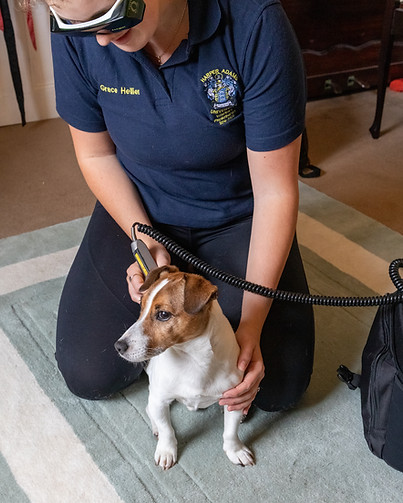Services

The canine or equine service I provide will encompass three steps: the first consists of skilled and accurate assessment of the animal, consisting of case history, static, dynamic, palpation and range of motion assessment. This will give a clear idea of how the animal is moving, feeling and behaving as a whole; highlighting any areas of muscle tension, pain or reduced function.
This leads to the second step: selection of treatments best suited for the case. Treatment by the veterinary physiotherapist will mainly consist of manual therapies such as massage, myofascial release techniques and stretching to alleviate pain, inflammation, reduce muscle tension and spasms as well as improve joint function. Electrotherapies may also be included such as H-wave, LASER and NMES therapy.



H-wave
In action:

H-Wave Therapy:
-
mimics muscle contraction and relaxation to increase circulation to the target area
-
increases lymphatic drainage (removing waste products of the body)
-
provides prolonged, cumulative effects
-
reduces pain
-
reduces muscle hypertonicity (tightness) and muscle spasms
LASER
In action:


LASER Therapy:
Low level laser therapy has a beneficial effect on the musculoskeletal system without causing tissue trauma. Its innovative qualities have made it an increasingly used therapeutic practise in veterinary medicine. It is predominantly used in practise for pain management and to improve tissue healing. The light energy creates a photochemical tissue response whereby the light is absorbed into cells to increase the production of ATP. ATP plays a role in the creation of proteins which have an important part in tissue repair, reduction of inflammation and pain relief. These effects significantly benefit musculoskeletal problems. Laser use can be daily, weekly or monthly for treatment and prevention.
Results include:
-
a beneficial effect on musculoskeletal pain (e.g. pain in the neck, back or hindquarters)
-
increased circulation
-
reduced inflammation
-
promotes tissue healing (such as muscle injuries and wound healing)
-
stimulates the production of endorphins (the 'happy hormone') to increase your animal's mental wellbeing and make them feel more relaxed.
NMES:


NMES Therapy:
A Neuromuscular Electrical Stimulation (NMES) unit comes with pads which can be placed securely on the dog. An electrical impulse is then sent through the pads which mimics the stimulation patterns of healthy nerves, causing assisted muscle contractions.
The aim on NMES is to strengthen muscle, mainly in animals that are unable to contract their muscle voluntarily. This is often in orthopaedic conditions where muscle recruitment and weight bearing is limited or should be avoided or neurological cases, for example, a Fibrocartilaginous Embolism in a dog (similar to a stroke in humans). Depending on the severity of the incident, dogs will often experience temporary partial or full loss of use of some, or all, of their limbs.
This inability to move their limbs (disuse) then causes disuse muscle atrophy (muscle loss). Meaning the chances of getting the dog back on their legs and using them correctly is at risk if they have lost a significant amount of muscular strength. Therefore, whilst the limbs are in disuse, it is so important to maintain as much muscle mass as possible. This can be done by the veterinary physiotherapist using therapies such as massage, stretching, passive range of motion, proprioceptive input and assisted exercises. NMES also falls under this category as it maintains muscle tissue and prevents further muscle atrophy from occurring.
Employing NMES in conjunction with manual therapies from a veterinary physiotherapist and carefully selected exercise programme can be very beneficial to a patient in rehabilitation.
Results include:
-
Increase in muscle strength
-
Increase in muscle mass
-
Increase in oxidative capacity of the muscle
-
Increased perfusion (the passage of fluid, e.g blood, through the circulatory system or lymphatic system to an organ or a tissue)
The last step involves creating a tailored remedial exercise programme. This will consist of exercises to work on your animal's strength, endurance, balance, proprioception, range of motion, and gait retraining. Exercises will consist of movements such as trotting poles, weaving, baited stretches and many more. These may be incorporated alongside other techniques in-between vet physio sessions.
Travel Expenses
As a mobile service, travel expenses are included in the cost if the distance is within the 30 mile catchment area of Gloucester, Gloucestershire.
If outside of the catchment area, I am still more than happy to travel to you, but a small travel cost will be included depending on the distance.
